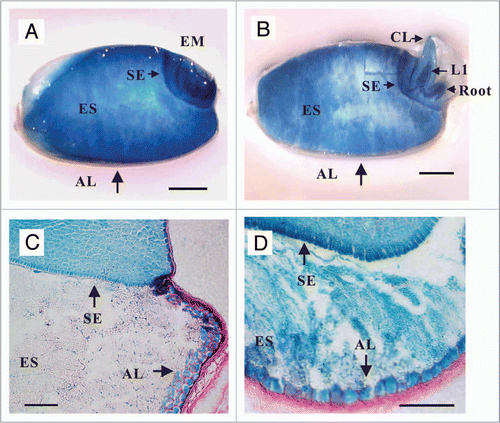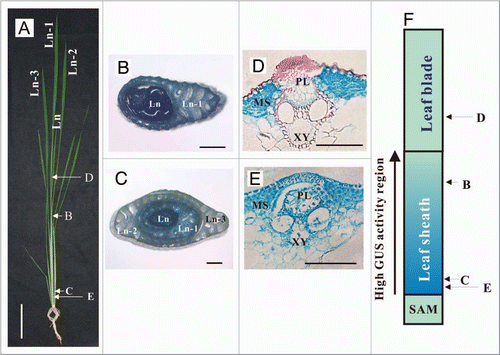Abstract
Previous studies on the activity of the rice Gα promoter using a β-Glucuronidase (GUS) reporter construct indicated that Gα expression was highest in developing organs and changed in a developmental stage-dependent manner. In this paper, GUS activity derived from the rice Gα promoter was analyzed in seeds and developing leaves. In seeds, GUS activity was detected in the aleurone layer, embryo, endosperm, and scutellar epithelium. In developing leaves, the activity was detected in the mesophyll tissues, phloem and xylem of the leaf sheath and in the mesophyll tissue of the leaf blade. The activity in the aleurone layer and scutellar epithelium suggests that the Gα subunit may be involved in gibberellin signaling. The activity in the mesophyll tissues of the leaf blade suggests that the Gα subunit may be related to the intensity of disease resistance. The pattern of the activity in the developing leaf also indicates that the expression of Gα follows a developmental profile at the tissue level.
The rice mutant d1 is deficient in the heterotrimeric G protein α subunit (Gα). Recently it was found that the dwarfism phenotype of d1 is due to a reduction in cell numbers.Citation1 This discovery has led to new questions regarding how rice Gα regulates cell number, and which other signaling molecules are involved in this process in various tissues and at different development stages. Studies of d1 suggest that rice Gα participates in both gibberellin signalingCitation2–Citation4 and brassinosteroid signaling.Citation5–Citation8 Promoter studies using the β-Glucuronidase (GUS) reporter indicate that Gα expression is highest in developing organs.Citation1 In this paper, we report on the expression pattern of a Gα promoter::GUS construct in seeds and developing leaves of rice.
Gα Promoter Activity in Rice Seeds
GUS staining patterns were analyzed in seeds of rice transformants expressing a Gα promoter::GUS construct (). GUS activity was detected in the aleurone layer (AL), embryo (EM), endosperm (ES) and scutellar epithelium (SE) of the dry seed (). Activity was also detected in the first leaf (L1), root, AL, ES and SE in the imbibed seed (). More detailed views of the SE and AL in the dry seed and the imbibed seed are shown in and D, respectively.
Gα Promoter Activity in the Developing Leaf
Next we analyzed GUS activity in leaves of transgenic plants in which the eighth leaf (Ln, n = 8) was developing (). Activity was highest in the developing leaf ( and C). Microscopic observations were carried out to obtain a more detailed view of the GUS expression profile. GUS activity was detected in the mesophyll tissue (MS) of the leaf blade () and the phloem (PL), xylem (XY) and MS of the leaf sheath ( and F).
Discussion
The heterotrimeric G protein may be involved in gibberellin signaling in seeds, because the Gα subunit was implicated in the expression of the α-amylase gene, which is induced by gibberellins.Citation2,Citation9 Furthermore, it was reported that the Gα subunit regulates transcript abundance in the AL.Citation3 Our results, indicating that GUS activity derived from the Gα promoter was detected in the AL, support the hypothesis that Gα is involved in gibberellin signal transduction in the AL. However, the presence of GUS protein in the dry seed indicated that the protein was synthesized and accumulated during seed maturation, because no translational activity occurs in the dry seed. Thus, the activity in the dry seed may not correctly reflect the actual Gα expression profile because the GUS protein may accumulate during maturation without degradation. In the future, it will be important to study whether the Gα protein actually accumulates in the dry seed, for example by a histological stain using an anti Gα antibody.
The d1 mutant, which is deficient in the Gα subunit, exhibited a reduced hypersensitive response after infection by rice blastCitation10,Citation11 and bacterial blight (Xoo).Citation12 Because the organs damaged during infection by rice blast and bacterial blight are leaves, the amount of Gα in the mesophyll tissues of the leaf blade may be related to the intensity of disease resistance.
GUS activity in developing leaves was detected in the MS, PL and XY of the leaf sheath, but only in the MS of the leaf blade. This result suggested that expression of the Gα gene had been deactivated in the PL and XY of the leaf blade. Thus, at the leaf stage shown in , the leaf blade may have finished developing and the leaf sheath may be continuing to develop. The results suggest that developmental stage is a critical factor in Gα expression at the tissue level.
There remain many undiscovered molecules and mechanisms involved in G protein signaling in plants. We expect that this study of the expression profile of the Gα subunit gene will be helpful in exploring the functions of the G proteins in rice.
Abbreviations
| AL | = | aleurone layer |
| EM | = | embryo |
| ES | = | endosperm |
| CL | = | coleoptile |
| MS | = | mesophyll tissues |
| PL | = | phloem |
| SE | = | scutellar epithelium |
| XY | = | xylem |
Figures and Tables
Figure 1 Gα promoter activity in rice seeds. Seeds of transgenic rice plants expressing the Gα promoter::GUS construct were stained to detect GUS activity. (A) Longitudinal section of a dry seed. (B) Longitudinal section of a seed imbibed for 2 days at 28°C. (C and D) More detailed views of the scutellar epithelium and aleurone layers shown in (A and B), respectively. AL, aleurone layer; EM, embryo; ES, endosperm; CL, coleoptile; L1, first leaf; SE, scutellar epithelium. Bars = 1 mm in (A and B) and 0.1 mm in (C and D).

Figure 2 Gα promoter activity in transgenic rice plants containing the Gα promoter::GUS construct. (A) A rice plant at the stage when the eighth leaf is expanding. (B and C) Cross sections of the eighth leaf indicated by arrows in (A). (D and E) More detailed views of the cross sections of the eighth leaf indicated by arrows in (A). (F) Diagram showing regions of the leaf analyzed in (A–E). Ln, leaf stage (L = leaf, n = 8 in this study); MS, mesophyll tissue; PL, phloem; XY, xylem; SAM, shoot apical meristem. Bars = 10 cm in (A), 1 mm in (B and C) and 0.1 mm in (D and E).

Addendum to:
References
- Izawa Y, Takayanagi Y, Inaba N, Abe Y, Minami M, Fujisawa Y, et al. Function and expression pattern of the α subunit of the heterotrimeric G protein in rice. Plant Cell Physiol 2010; 51:271 - 281
- Ueguchi-Tanaka M, Fujisawa Y, Kobayashi M, Ashikari M, Iwasaki Y, Kitano H, et al. Rice dwarf mutant d1, which is defective in the α subunit of the heterotrimeric G protein, affects gibberellin signal transduction. Proc Natl Acad Sci USA 2000; 97:11638 - 11643
- Bethke PC, Hwang Y, Zhu T, Jones RL. Global patterns of gene expression in the aleurone of wild-type and dwarf1 mutant rice. Plant Physiol 2006; 140:484 - 498
- Khan MMK, Yang S, Iwasaki Y, Fujisawa Y, Fukuda H, Komatsu S. A gibberellin-regulated protein phosphorylated by a putative Ca2+-dependent protein kinase is G-protein mediated in rice root. Plant Cell Environ 2005; 28:679 - 687
- Oki K, Inaba N, Kitagawa K, Fujioka S, Kitano H, Fujisawa Y, et al. Function of the α subunit of rice heterotrimeric G protein in brassinosteroid signaling. Plant Cell Physiol 2009; 50:161 - 172
- Oki K, Kitagawa K, Fujisawa Y, Kato H, Iwasaki Y. Function of α subunit of heterotrimeric G protein in brassinosteroid response of rice plants. Plant Signal Behav 2009; 4:1 - 3
- Yang G, Matsuoka M, Iwasaki Y, Komatsu S. A novel brassinolide-enhanced gene identified by cDNA microarray is involved in the growth of rice. Plant Mol Biol 2003; 52:843 - 854
- Wang L, Xu YY, Ma QB, Li D, Xu ZH, Chong K. Heterotrimeric G protein α subunit is involved in rice brassinosteroid response. Cell Res 2006; 16:916 - 922
- Jones HD, Smith SJ, Desikan R, Plakidou-Dymock S, Lovegrove A, Hooley R. Heterotrimeric G proteins are implicated in gibberellin induction of α-amylase gene expression in wild oat aleurone. Plant Cell 1998; 10:245 - 253
- Suharsono U, Fujisawa Y, Kasawaki T, Iwasaki Y, Satoh H, Shimamoto K. The heterotrimeric G protein α subunit acts upstream of the small GTPase Rac in disease resistance of rice. Proc Natl Acad Sci USA 2002; 99:13307 - 13312
- Iwata M, Umemura K, Teraoka T, Usami H, Fujisawa Y, Iwasaki Y. Role of the α subunit of heterotrimeric G-protein in probenazole-inducing defense signaling in rice. J Gen Plant Pathol 2003; 69:83 - 86
- Komatsu S, Yang G, Hayashi N, Kaku H, Umemura K, Iwasaki Y. Alterations by a defect in a rice G protein α subunit in probenazole and pathogen-induced responses. Plant Cell Environ 2004; 27:947 - 957